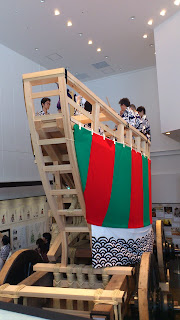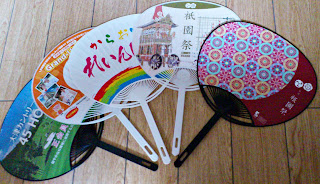The Japanese believe that the spirits of their ancestors return home for a reunion during Obon so many return to their hometowns for this "reunion", typically from 13 to 16 August. A number of companies and shops closed for business during the period since many people would take vacation leave anyway, to spend time with families, clean ancestors' graves or set up praying rites. Obon is like a combination of Singapore's Hungry Ghost Festival and Qing Ming Festival.
The Gozan Okuribi, literally translated as "Five Mountains Send-off Fires", is a signature Obon tradition of Kyoto. It is held every year on 16 August to mark the end of the Obon Festival. Giant bonfires are lit on five mountains surrounding Kyoto to guide the spirits back to their world.
The talk of the day among my friends in the lead-up to this anticipated event was where to see as many of the bonfires as possible; the fires would be lit in the form of certain characters and motifs. On 16 August at about 6pm (two hours before the bonfires), I made my way to Funaokayama Park which was said to offer a good vantage point.
 |
| Hidari Daimonji in the day. It is one of the mountains of Gozan Okuribi. |
The talk of the day among my friends in the lead-up to this anticipated event was where to see as many of the bonfires as possible; the fires would be lit in the form of certain characters and motifs. On 16 August at about 6pm (two hours before the bonfires), I made my way to Funaokayama Park which was said to offer a good vantage point.
 |
Can you see the end of this narrow street? It was from
that end where I noticed a crowd and so decided to walk
down this street to check it out.
|
As I was enjoying my walk, I saw a group of people congregating at the other end of a narrow side street I had just passed. Having spent some years patrolling streets in my younger days, I have developed a propensity to check out assemblies of people along the streets. Naturally, I turned into the narrow street which opened into a residential area. The group of people were obviously waiting for something to happen, as many of them were armed with cameras. I saw fire-fighters on stand-by as well.
I turned to a young lady to ask what was going on. "It is related to Obon but I don't know the details," came the answer. I noticed that amidst the row of houses before me was a small temple so I went in to see if I could obtain some leads. A monk was chanting and a group of men in happi and a couple of firemen were watching over the fire burning in a fire urn. As I pieced the images together, I began to understand.
 |
| People congregated outside a small temple which is amidst a row of houses, waiting for the Gozan Okuribi procession. |
I went back to the lady I approached earlier and asked, "When the procession goes up the Hidari Daimonji to light up the bonfires, can all of us here go together?" Hidari Daimonji is the nearest mountain where one of the bonfires would be lit. "I don't think the public is allowed to go up," she said. As I waited with the crowd, I overheard the conversation of two ojiisans beside me. One of them said he travelled from his hometown to witness this Kyoto tradition every year.
 |
| Firemen on stand-by inside the temple where the huge fire torch standing
on the left would be lit.
|
"Excuse me, could you tell me what kind of event is being held here now, please?" I asked. "The procession up the Hidari Daimonji will start here. The fire on the mountain you will see later comes from this temple. There will be a huge fire torch brought up from here to the mountain," said the ojiisan, confirming my guess.
I had tried to research on the internet if there was a procession somewhere but didn't manage to get much information. Yet, by a fluke, I had stumbled upon it. Here was a chance to see the procession up close! And perhaps, perhaps there was a chance of going up the mountain too? It was a hot summer evening, but I shivered in excitement at the thought.
 |
| Heading for the Hidari Daimonji to light the bonfires. At around this time, members of the procession to other mountains should be getting ready for their hike up the mountains too. |
By about 7.30pm, the street in front of the temple was crowded with onlookers, many of whom appeared to be part of Japanese tour groups. At about 7.45pm, men in happi carrying small torches came running out from the temple. And then, the huge torch ablaze with fire appeared, carried by two young men.
"Ganbatte! Ganbatte ne!" the people lining both sides of the streets cheered. A number of them appeared to be families of the men carrying the torches, and they were shouting out words of encouragement to the men. I gathered later from internet searches that specific families in Kyoto took charge of maintaining the Gozan Okuribi custom on a voluntary basis.
As the men with the torches moved ahead, so did I along with some of their family members and other onlookers. I could not remember how far I walked before I realised that I was the only "onlooker" left following the procession. The group came to a stop at a small gate, which opened into a steep flight of steps leading up the mountain where the bonfire was to be lit. In single file, the members of the procession went up the steps. The words of the lady I met earlier came to mind. "The public is not supposed to go up the mountain."
I am going to be discovered, I thought. For a split second, I thought about giving it a go and see what sort of response I would receive. I had come this far afterall. As I stood contemplating my circumstances, I sensed a pain in my knee. I had recently fell off my bicycle and was still nursing my injury. I looked at the flight of steps before me and reluctantly accepted the reality. Slowly, I retreated.
 |
| Back at the main street. |
 |
| People lined both sides of the road. |
Back at the main street with a direct view of Hidari Daimonji, crowds of people were on stand-by with their cameras poised. An ojiisan perched himself on a ladder he had brought along for a better view. Concerned that I would miss the bonfires by the time I arrived at Funaokayama Park, I decided to join the crowd observing Hidari Daimonji. Slightly after 8pm, the bonfires began. Satisfied and still with some hope remaining, I left the spot at Hidari Daimonji heading for Funaokayama Park.
 |
| View from Funaokayama Park. |
When I reached the peak of the park where the five mountains could be seen, most of the bonfires were already snuffed out. I stood there for a while, superimposing the images of the fires from the travel guides that I had seen onto the mountains. Happy with what I saw in my mind, I left the park, eager to tell my story.






























